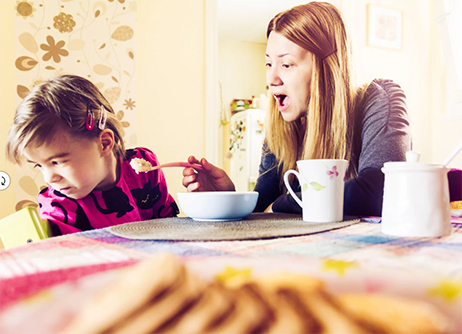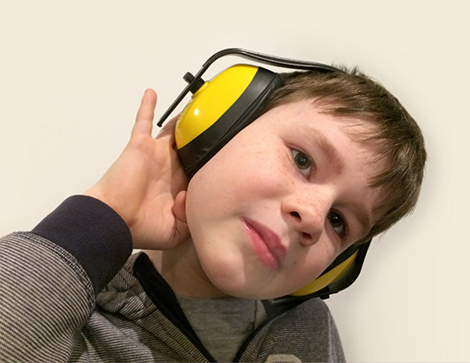Neurodivergence
It can be challenging to feed a neurodivergent child without resorting to pressure. Neurodivergent children are more likely to struggle with texture sensitivity or prefer to eat the same foods the same way, over and over again. Family meals can become a battlegroundwhere you want your child to eat the same meal as the rest of the family but your child wants toeat chicken nuggets for breakfast, lunch and supper. There is a lot of pressure on parents and caregivers to change the way their child eats and to do it quickly.

As a parent or caregiver, your role is to decide what foods to offer, when to offer food and where to offer food.
Your child’s job is to decide if they are going to eat those foods and how much to eat at each meal and snack. At ESI, we are looking for children to become Eating Competent over time. This is about more than what foods your child eats, it’s about the feeding relationship.
A feeding relationship based on trust allows children to eat enough of foods they enjoy to grow the way that they are meant to grow. They learn to enjoy family meals based on the drive to eat. Over time, they will learn to enjoy many of the foods the family eats.
What
Neurodivergent children often prefer highly processed foods. These foods are extremely consistent in their appearance, texture and flavor. The Satter Division of Responsibility in Feeding advises offering foods that children generally like to eat, or “core” foods at each meal and snack. So, your child’s preferred foods can be part of what’s offered regularly as core foods. Over time, your child may become comfortable with different foods that they see other family members eating and drinking, when there is no pressure to try them.
But remember, you decide what foods are offered at each meal and snack. At ESI we say to be “considerate without catering”. That is, always including a core or safe food, when offering something new. On the other hand, that doesn’t mean preparing whatever the child asks for at a particular meal or snack.
Core Foods
A core food is something that your child eats regularly. If your child needs texture modifications, try to modify the family foods as much as you are able so they are included in the meal. If your child eats less than 10 foods regularly, seek the support of a registered dietitian to ensure they are not at risk for nutrient deficiencies.
Neurodivergent children often prefer highly processed foods. These foods are extremely consistent in their appearance, texture and flavor. The Satter Division of Responsibility in Feeding advises offering foods that children generally like to eat, or “core” foods at each meal and snack. So, your child’s preferred foods can be part of what’s offered regularly as core foods. Over time, your child may become comfortable with different foods that they see other family members eating and drinking, when there is no pressure to try them.
But remember, you decide what foods are offered at each meal and snack. At ESI we say to be “considerate without catering”. That is, always including a core or safe food, when offering something new. On the other hand, that doesn’t mean preparing whatever the child asks for at a particular meal or snack.
Core Foods
A core food is something that your child eats regularly. If your child needs texture modifications, try to modify the family foods as much as you are able so they are included in the meal. If your child eats less than 10 foods regularly, seek the support of a registered dietitian to ensure they are not at risk for nutrient deficiencies.
When
The structure of having regular meal and snack times is key to success with the Satter Division of Responsibility in Feeding. Depending on the age of the child, they may need to eat every 2-3 hours. Plan to offer meals and snacks at consistent times and only offer water in between. This helps your child come to the table hungry and ready to eat but not so hungry that they become dysregulated.

The structure of having regular meal and snack times is key to success with the Satter Division of Responsibility in Feeding. Depending on the age of the child, they may need to eat every 2-3 hours. Plan to offer meals and snacks at consistent times and only offer water in between. This helps your child come to the table hungry and ready to eat but not so hungry that they become dysregulated.

Whether and How Much
Trust your child to decide how much to eat at each meal and snack. But be aware that it is common for all children to eat a lot one day and almost nothing the next.
Your child may stick with their core foods for some time, but exposing them to new foods without pressure at family meals and snacks will help them to become more comfortable with new foods over time.
On the other hand, if your child is struggling with growth, you may want to seek the support of a registered dietitian with experience in the Satter approach.

Trust your child to decide how much to eat at each meal and snack. But be aware that it is common for all children to eat a lot one day and almost nothing the next.
Your child may stick with their core foods for some time, but exposing them to new foods without pressure at family meals and snacks will help them to become more comfortable with new foods over time.
On the other hand, if your child is struggling with growth, you may want to seek the support of a registered dietitian with experience in the Satter approach.

Where
Neurodivergent children often love routine so eating in the same place every day can help them be more comfortable and able to focus on eating. They’ll also do better at the table if their seat is comfortable, including be supported physically if needed.
While it is best to avoid distractions such as toys and screens at the table, neurodivergent children may need some extra accommodation to do well at shared meals and snacks.

Neurodivergent children often love routine so eating in the same place every day can help them be more comfortable and able to focus on eating. They’ll also do better at the table if their seat is comfortable, including be supported physically if needed.
While it is best to avoid distractions such as toys and screens at the table, neurodivergent children may need some extra accommodation to do well at shared meals and snacks.




